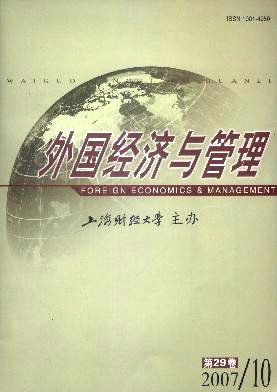企业动态能力理论模型研究综述
外国经济与管理 2007 年 第 29 卷第 10 期, 页码:9 - 16
摘要
参考文献
摘要
本文在对企业动态能力的现实和理论背景进行分析的基础上,阐述了动态能力的概念演进和核心内涵。从当前的研究看,企业动态能力的理论模型可以概括为阶层分类模型、战略整合模型、双重过程模型和组织学习模型四种。它们从不同的角度揭示了动态能力的本质特征,为企业构建动态能力的实践奠定了理论基础。
[1]Teece,D J,Pisano,G,and Shuen,A.Dynamic capabilities and strategic management[J].Strategic Management Journal,1997,18(7):509-533.
[2]Barney,J B.Firm resources and sustained competitive advantage[J].Journal of Management,1991,17(1):99-120.
[3]Prahalad,C K,and Hamel,G.The core competence of the corporation[J].Harvard Business Review,1990,68(3):79-95.
[4]Mosakowski,E,and McKelvey,B.Predicting rent generation in competence-based competition[A].in Heene,A,and Sanchez,R(Eds.).Competence-based strategic Management[C].Chichester:Wiley,1997:65-85.
[5]Leonard-Barton,D.Core capabilities and core rigidities:A paradox in managing new product development[J].Strategic ManagementJournal,1992,13(2):111-125.
[6]D’Aveni,R A.Hyper competition:Managing the dynamics of strategic maneuvering[M].New York:Free Press,1994.
[7]Teece,D J,and Pisano,G.The dynamic capabilities of firm:An introduction[J].Industrial and Corporate Change,1994,3(3):537-556.
[8]Collis,D J.Research note:How valuable are organizational capabilities[J].Strategic Management Journal,1994,15(1):143-152.
[9]Winter,S G.The satisfying principle in capability learning[J].Strategic Management Journal,2000,21(3):981-996.
[10]Cepeda,G,and Vera,D.Dynamic capabilities and operational capabilities:A knowledge management perspective[J].Journal ofBusiness Research,2007,60:426-437.
[11]Wang,C L,and Ahmed,P K.Dynamic capabilities:A review and research agenda[J].International Journal of Management Re-view,2007,9(1):31-51.
[12]Eisenhardt,K M,and Martin,J A.Dynamic capabilities:What are they[J].Strategic Management Journal,2000,21(4):1 105-1 121.
[13]Schreyogg,G,and Kliesch-Eberl,M.How dynamic can organizational capabilities be?Towards a dual-process model of capabilitydynamization[J].Strategic Management Journal,2007,28(4):15-24.
[14]Esser,J K.Alive and well after 25 years:A review of groupthink research[J].Organizational Behavior and Human Decision Proces-ses,1998,73(2):116-141.
[15]Brockner,J.The escalation of commitment to a failing course of action:Toward theoretical progress[J].Academy of ManagementReview,1992,17(1):39-61.
[16]Zahra,S A,Sapienza,H J,and Davidsson,P.Entrepreneurship and dynamic capabilities:A review,model and research agenda[J].Journal of Management Studies,2006,43(4):917-955.
[17]Zollo,M,and Winter,S G.Deliberate learning and the evolution of dynamic capabilities[J].Organization Science,2002,13(3):339-351.
[18]Argyris,C.Single-loop and double-loop models in research on decision making[J].Administrative Science Quarterly,1976,21(3):363-375.
[19]March,J G.Exploration and exploitation in organizational learning[J].Organization Science,1991,2(1):71-87.
[20]Gavetti,G,and Levinthal,D.Looking forward and look backward:Cognitive and experiential search[J].Administrative ScienceQuarterly,2000,45(1):113-137.
[2]Barney,J B.Firm resources and sustained competitive advantage[J].Journal of Management,1991,17(1):99-120.
[3]Prahalad,C K,and Hamel,G.The core competence of the corporation[J].Harvard Business Review,1990,68(3):79-95.
[4]Mosakowski,E,and McKelvey,B.Predicting rent generation in competence-based competition[A].in Heene,A,and Sanchez,R(Eds.).Competence-based strategic Management[C].Chichester:Wiley,1997:65-85.
[5]Leonard-Barton,D.Core capabilities and core rigidities:A paradox in managing new product development[J].Strategic ManagementJournal,1992,13(2):111-125.
[6]D’Aveni,R A.Hyper competition:Managing the dynamics of strategic maneuvering[M].New York:Free Press,1994.
[7]Teece,D J,and Pisano,G.The dynamic capabilities of firm:An introduction[J].Industrial and Corporate Change,1994,3(3):537-556.
[8]Collis,D J.Research note:How valuable are organizational capabilities[J].Strategic Management Journal,1994,15(1):143-152.
[9]Winter,S G.The satisfying principle in capability learning[J].Strategic Management Journal,2000,21(3):981-996.
[10]Cepeda,G,and Vera,D.Dynamic capabilities and operational capabilities:A knowledge management perspective[J].Journal ofBusiness Research,2007,60:426-437.
[11]Wang,C L,and Ahmed,P K.Dynamic capabilities:A review and research agenda[J].International Journal of Management Re-view,2007,9(1):31-51.
[12]Eisenhardt,K M,and Martin,J A.Dynamic capabilities:What are they[J].Strategic Management Journal,2000,21(4):1 105-1 121.
[13]Schreyogg,G,and Kliesch-Eberl,M.How dynamic can organizational capabilities be?Towards a dual-process model of capabilitydynamization[J].Strategic Management Journal,2007,28(4):15-24.
[14]Esser,J K.Alive and well after 25 years:A review of groupthink research[J].Organizational Behavior and Human Decision Proces-ses,1998,73(2):116-141.
[15]Brockner,J.The escalation of commitment to a failing course of action:Toward theoretical progress[J].Academy of ManagementReview,1992,17(1):39-61.
[16]Zahra,S A,Sapienza,H J,and Davidsson,P.Entrepreneurship and dynamic capabilities:A review,model and research agenda[J].Journal of Management Studies,2006,43(4):917-955.
[17]Zollo,M,and Winter,S G.Deliberate learning and the evolution of dynamic capabilities[J].Organization Science,2002,13(3):339-351.
[18]Argyris,C.Single-loop and double-loop models in research on decision making[J].Administrative Science Quarterly,1976,21(3):363-375.
[19]March,J G.Exploration and exploitation in organizational learning[J].Organization Science,1991,2(1):71-87.
[20]Gavetti,G,and Levinthal,D.Looking forward and look backward:Cognitive and experiential search[J].Administrative ScienceQuarterly,2000,45(1):113-137.
引用本文
孟晓斌, 王重鸣, 杨建锋. 企业动态能力理论模型研究综述[J]. 外国经济与管理, 2007, 29(10): 9–16.
导出参考文献,格式为:
下一篇:国外商业模式理论研究评介





 11261
11261  253
253

